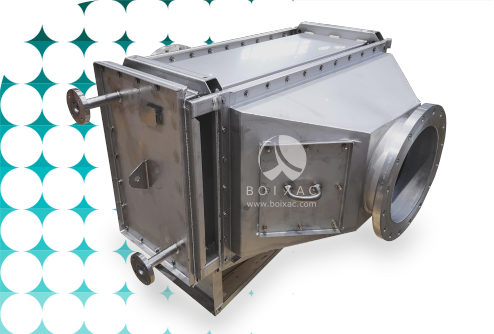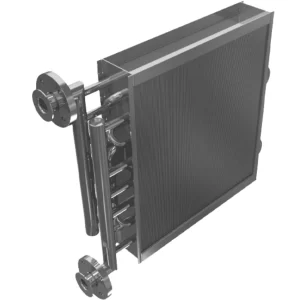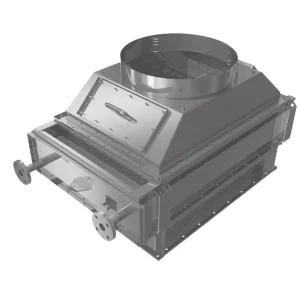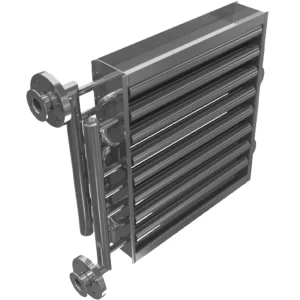ECONOMIZER
HEAT RECOVERY SYSTEM IN AN INDUSTRIAL BOILER
In the context of industrial production, energy efficiency is a key factor in reducing operating costs and minimizing environmental impact. Industrial boilers are essential for many processes, such as steam generation, water heating, or thermal oil heating. One of the key components that improve the efficiency of these boilers is the heat economizer or heat recovery system. This device allows for the recovery of thermal energy from exhaust gases that, without this technology, would be lost. In this article, we will explore how an economizer works in a two-pass industrial boiler, using a heat exchanger to efficiently transfer thermal energy to fluids such as steam, superheated water, or thermal oil.
What is an economizer?
An economizer is a device that recovers the residual heat from the exhaust gases of a boiler to heat the feedwater before it enters the boiler. This way, the system increases the thermal efficiency of the boiler and reduces fuel consumption. The principle of operation of an economizer is based on the use of a heat exchanger that transfers thermal energy from the combustion gases to an incoming fluid, usually water or another thermal substance. This way, the feedwater reaches the boiler at a higher temperature, reducing the amount of energy required to heat it to its final use.

How an economizer works in a Two-Pass Industrial Boiler
Two-pass industrial boilers, also known as double-pass or double-circuit boilers, have a structure designed to optimize the heat transfer of combustion gases. This type of boiler is designed to maximize the utilization of exhaust gas energy by using two circuits of gas flow. In this context, the economizer is installed in the first pass of the exhaust gases before passing through the boiler heat exchanger.
Exhaust gases and heat exchanger: When fuel is burned inside the boiler, the generated gases have a very high temperature. The gases exit the boiler and circulate through the first circuit, passing through the economizer. This is where the heat recovery system takes advantage of this residual heat to transfer it to the feedwater through a steam or water heat exchanger.
Heat transfer: The heat exchanger used in the economizer can be a steam heat exchanger, a superheated water heat exchanger, or even a system designed to heat thermal oil. Each of these systems uses a similar principle: the exhaust gases transfer their heat to the circulating fluid, raising the temperature of the feedwater before entering the boiler. This allows the boiler to use less fuel to reach the required temperature to generate steam or heat other thermal fluids.
Energy efficiency improvement: The feedwater, once heated thanks to the economizer, enters the boiler at a higher temperature. This means that the boiler will need less energy to heat it to the desired operating temperature. This fuel saving directly translates into a reduction in operating costs and a greater environmental sustainability for the plant.
Economizer design and materials: To ensure efficient heat transfer, industrial economizers are often made from materials resistant to high temperatures and corrosion, such as stainless steel or special materials for extreme operating conditions. These materials ensure that the devices have a longer lifespan and are efficient under demanding working conditions.
Types of economizers used
The design of the economizer depends on the type of fluid to be heated and the specific conditions of each industrial plant. Below are the most common types of heat exchangers used:
Steam heat exchanger: In some cases, the boiler needs to generate steam for industrial processes. A steam heat exchanger allows the use of exhaust gas energy to raise the temperature of the water before it reaches the boiler, thus facilitating steam production with less energy.
Superheated water heat exchanger: When it is necessary to heat water beyond its saturation temperature, a superheated water heat exchanger is used. This system keeps the water in a superheated state for specific industrial applications, such as heat production or energy generation.
Thermal oil heat exchanger: For industrial processes that require heating at high temperatures, thermal oil is a popular option. Thermal oil heat exchangers are specifically designed to transfer heat from exhaust gases to the oil, allowing the system to maintain a constant and efficient temperature throughout the process.
Advantages of using an economizer
Among the many advantages offered by the use of Economizers and Heat Recovery Units, we can highlight:
Reduction in fuel consumption: One of the main advantages of installing an economizer is the significant reduction in fuel consumption. By recovering residual heat, less energy is needed to reach the desired operating temperature.
Increase in overall efficiency: Thanks to the recovery of residual heat, the overall efficiency of the heating system significantly improves, which contributes to a smaller carbon footprint.
Economic savings: Operating costs decrease since the boiler requires less fuel to generate the same amount of steam or heat water.
Sustainability: Reducing fuel consumption not only provides economic benefits but also contributes to sustainability by minimizing the environmental impact of industrial operations.
In this sense, economizers or heat recovery systems in two-pass industrial boilers are essential components for improving energy efficiency and reducing operating costs in industrial processes. By using steam, superheated water, or thermal oil heat exchangers, the thermal energy from exhaust gases can be used to heat fluids such as feedwater. This way, a more efficient and sustainable system is achieved, contributing to resource optimization and reducing environmental impact.
BOIXAC, A WORLD OF INDUSTRIAL ENERGY RECOVERY
We have a wide range of different technologies, including smooth tube heat exchangers, finned tube heat exchangers, and pillow plate exchangers. This constructive variety allows us to customize the solutions we propose, adapting to the reality of each production process and thus optimizing the thermal resources available at each plant.
Our advanced technical knowledge enables us to offer a range of economizers and heat recovery systems capable of working with combustion gases below their dew point, thus allowing condensation and recovery of acidic condensates from the gases themselves. Naturally, we use top-quality materials, specially selected for these purposes and subjected to rigorous quality controls.
Additionally, we highlight the meticulously studied design, which, through a clamp-like structure, allows heat exchangers to be extracted without manipulating the duct or chimney structure. This makes the economizers and heat recovery systems removable, facilitating easy access for both maintenance and cleaning.
We offer additional features such as the possibility of including thermal insulation with rock wool and a metal sheet finish, preventing thermal losses and improving the efficiency of energy recovery systems. We can also incorporate automatic cleaning systems, such as spray cleaning, rectangular-to-circular transitions to adapt to duct diameters, air distribution baffles, quality dossiers, and more. An important factor to emphasize is the ability to design economizers and heat recovery systems that do not require additional support structures.



